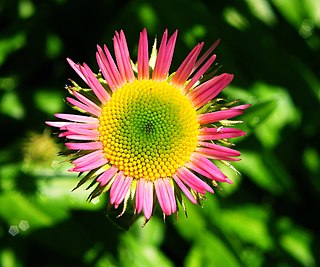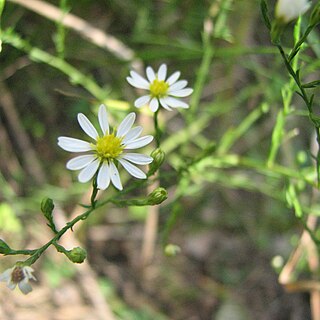
Goldenrod is a common name for many species of flowering plants in the sunflower family, Asteraceae, commonly in reference to the genus Solidago.

Symphyotrichum is a genus of over 100 species and naturally occurring hybrids of herbaceous annual and perennial plants in the composite family Asteraceae, most which were formerly treated within the genus Aster. The majority are endemic to North America, but several also occur in the West Indies, Central and South America, as well as in eastern Eurasia. Several species have been introduced to Europe as garden specimens, most notably New England aster and New York aster.

Astereae is a tribe of plants in the family Asteraceae that includes annuals, biennials, perennials, subshrubs, shrubs, and trees. Plants within the tribe are present nearly worldwide divided into 170 genera and more than 2,800 species, making it the second-largest tribe in the family behind Senecioneae. They are found primarily in temperate regions of the world.
Astranthium, or Western-daisy, is a North American genus of flowering plants in the family Asteraceae. Astranthium is native to the United States and Mexico.
Benitoa is a genus of flowering plants in the family Asteraceae.
Chrysoma is a genus of flowering plants in the family Asteraceae.
Columbiadoria is a small North American genus of flowering plants in the family Asteraceae.
Gundlachia, commonly called goldenshrub, is a genus of flowering plants in the family Asteraceae.
Laennecia or Laënnecia is a genus of flowering plants in the family Asteraceae. The plants are native to Mesoamerica, South America, and the southwestern United States. Common name is "horseweed."
Oonopsis, or false goldenweed, is a genus of flowering plants in the family Asteraceae.

Oreostemma is a genus of flowering plants in the family Asteraceae. Species are found in western North America, with two endemic to California.

Podocoma is a genus of South American plants in the tribe Astereae within the family Asteraceae.

Rayjacksonia is a genus of North American flowering plants in the family Asteraceae. It is one of several genera with the common name tansyaster.
Tonestus, common name serpentweed, is a genus of North American flowering plants in the family Asteraceae.
Xanthocephalum is a genus of North American plants in the tribe Astereae within the family Asteraceae.

Symphyotrichum depauperatum, commonly known as serpentine aster or starved aster, is a rare species in the family Asteraceae adapted to serpentine barrens, an ecosystem with a high concentration of toxic metals in the soil. It has been found in Pennsylvania, Maryland, and on some diabase glades in North Carolina. It grows to 50 centimeters and has white ray florets surrounding a center of yellow disk florets.

Solidago houghtonii is a rare North American species of flowering plant in the family Asteraceae known as Houghton's goldenrod. It is native to southern Ontario, Canada and the northern United States. It is threatened by the loss and degradation of its habitat. It is a federally listed threatened species of the United States and it is designated a species of special concern by Canada's Committee on the Status of Endangered Wildlife in Canada.

Symphyotrichum dumosum is a species of flowering plant of the family Asteraceae commonly known as rice button aster and bushy aster. It is native to much of eastern and central North America, as well as Haiti and Dominican Republic. It is a perennial, herbaceous plant that may reach a height of 1 meter.
Sanrobertia is a monotypic genus of flowering plant within the subtribe Symphyotrichinae of the family Asteraceae. Sanrobertia gypsophila is endemic to Nuevo León, Mexico.








